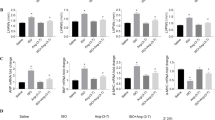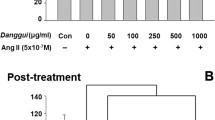Abstract
Objective
To investigate the effects of evodiamine (Evo), a component of Evodiaminedia rutaecarpa (Juss.) Benth, on cardiomyocyte hypertrophy induced by angiotensin II (Ang II) and further explore the potential mechanisms.
Methods
Cardiomyocytes from neonatal Sprague Dawley rats were isolated and characterized, and then the cadiomyocyte cultures were randomly divided into control, model (Ang II 0.1 μmol/L), and Evo (0.03, 0.3, 3 μmol/L) groups. The cardiomyocyte surface area, protein level, intracellular free calcium ([Ca2+]i) concentration, activity of nitric oxide synthase (NOS) and content of nitric oxide (NO) were measured, respectively. The mRNA expressions of atrial natriuretic factor (ANF), calcineurin (CaN), extracellular signal-regulated kinase-2 (ERK-2), and endothelial nitric oxide synthase (eNOS) of cardiomyocytes were analyzed by real-time reverse transcriptionpolymerase chain reaction. The protein expressions of calcineurin catalytic subunit (CnA) and mitogen-activated protein kinase phosphatase-1 (MKP-1) were detected by Western blot analysis.
Results
Compared with the control group, Ang II induced cardiomyocytes hypertrophy, as evidenced by increased cardiomyocyte surface area, protein content, and ANF mRNA expression; increased intracellular free calcium ([Ca2+]i) concentration and expressions of CaN mRNA, CnA protein, and ERK-2 mRNA, but decreased MKP-1 protein expression (P<0.05 or P<0.01). Compared with Ang II, Evo (0.3, 3 μmol/L) significantly attenuated Ang II-induced cardiomyocyte hypertrophy, decreased the [Ca2+]i concentration and expressions of CaN mRNA, CnA protein, and ERK-2 mRNA, but increased MKP-1 protein expression (P<0.05 or P<0.01). Most interestingly, Evo increased the NOS activity and NO production, and upregulated the eNOS mRNA expression (P<0.05).
Conclusion
Evo signifificantly attenuated Ang II-induced cardiomyocyte hypertrophy, and this effect was partly due to promotion of NO production, reduction of [Ca2+]i concentration, and inhibition of CaN and ERK-2 signal transduction pathways.
Similar content being viewed by others
References
Nakaoka Y, Shioyama W, Kunimoto S, Arita Y, Higuchi K, Yamamoto K, et al. SHP2 mediates gp130-dependent cardiomyocyte hypertrophy via negative regulation of skeletal alpha-actin gene. J Mol Cell Cardiol 2010;49:157–164.
Heineke J, Molkentin JD. Regulation of cardiac hypertrophy by intracellular signalling pathways. Nat Rev Mol Cell Biol 2006;7:589–600.
Sadoshima J, Qiu Z, Morgan JP, Izumo S. Angiotensin II and other hypertrophic stimuli mediated by G protein-coupled receptors activate tyrosine kinase, mitogen-activated protein kinase, and 90-kD S6 kinase in cardiac myocytes. The critical role of Ca2+-dependent signaling. Circ Res 1995;76:1–15.
Zhao Z, Wang W, Geng J, Wang L, Su G, Zhang Y, et al. Protein kinase C epsilon-dependent extracellular signalregulated kinase 5 phosphorylation and nuclear translocation involved in cardiomyocyte hypertrophy with angiotensin II stimulation. J Cell Biochem 2010;109:653–662.
Kim S, Iwao H. Molecular and cellular mechanisms of angiotensin II-mediated cardiovascular and renal diseases. Pharmacol Rev 2000;52:11–34.
Pedram A, Razandi M, Aitkenhead M, Levin ER. Estrogen inhibits cardiomyocyte hypertrophy in vitro. Antagonism of calcineurin-related hypertrophy through induction of MCIP1. J Biol Chem 2005;280:26339–26348.
Houser, SR. Ca2+ signaling domains responsible for cardiac hypertrophy and arrhythmias. Circ Res 2009;104:413–415.
Nakayama H, Bodi I, Correll RN, Chen X, Lorenz J, Houser SR, et al. alpha1G-dependent T-type Ca2+ current antagonizes cardiac hypertrophy through α NOS3-dependent mechanism in mice. J Clin Invest 2009;119:3787–3796.
Bueno OF, Molkentin JD. Involvement of extracellular signal-regulated kinase 1/2 in cardiac hypertrophy and cell death. Circ Res 2002;91:776–781.
Marshall AK, Barrett OP, Cullingford TE, Shanmugasundram A, Sugden PH, Clerk A, et al. ERK1/2 signaling dominates over RhoA signaling in regulating early changes in RNA expression induced by endothelin-1 in neonatal rat cardiomyocytes. PLoS One 2010;5:e10027.
Fiedler B, Lohmann SM, Smolenski A, Linnemuller S, Pieske B, Schroder F, et al. Inhibition of calcineurin-NFAT hypertrophy signaling by cGMP-dependent protein kinase type I in cardiac myocytes. Proc Natl Acad Sci USA 2002;99:11363–11368.
Jiang J, Hu C. Evodiamine: a novel anti-cancer alkaloid from Evodia rutaecarpa. Molecules 2009;14:1852–1859.
Wu CL, Hung CR, Chang FY, Lin LC, Pau KY, Wang PS. Effects of evodiamine on gastrointestinal motility in male rats. Eur J Pharmacol 2002;457:169–176.
Wei J, Ching LC, Zhao JF, Shyue SK, Lee HF, Kou YR, et al. Essential role of transient receptor potential vanilloid type 1 in evodiamine-mediated protection against atherosclerosis. Acta Physiol (Oxf) 2013;207:299–307.
Bak EJ, Park HG, Kim JM, Kim JM, Yoo YJ, Cha JH. Inhibitory effect of evodiamine alone and in combination with rosiglitazone on in vitro adipocyte differentiation and in vivo obesity related to diabetes. Int J Obes (Lond) 2010;34:250–260.
Yang J, Cai X, Lu W, Hu C, Xu X, Yu Q, et al. Evodiamine inhibits STAT3 signaling by inducing phosphatase shatterproof 1 in hepatocellular carcinoma cells. Cancer Lett 2013;328:243–251.
Yu PL, Chao HL, Wang SW, Wang PS. Effects of evodiamine and rutaecarpine on the secretion of corticosterone by zona fasciculata-reticularis cells in male rats. J Cell Biochem 2009;108:469–475.
Gao YS, Sun AS, He N, Wu Q, Yang DL. Inhibitory effect of the extracts of Euodiae Fructus on right ventricular hypertrophy and calcineurin of rats. Chin Pharm (Chin) 2011;22:2508–2510.
Jiang QS, Huang XN, Yang GZ, Jiang XY, Zhou QX. Inhibitory effect of ginsenoside Rb1 on calcineurin signal pathway in cardiomyocyte hypertrophy induced by prostaglandin F2α. Acta Pharmacol Sin 2007;28:1149–1154.
Yang JH, Ma CG, Cai Y, Pan CS, Zhao J, Tang CS, et al. Effect of intermedin1-53 on angiotensin II-induced hypertrophy in neonatal rat ventricular myocytes. J Cardiovasc Pharmacol 2010;56:45–52.
Carreño JE, Apablaza F, Ocaranza MP, Jalil JE. Cardiac hypertrophy: molecular and cellular events. Rev Esp Cardiol 2006;59:473–486.
Hunter JJ, Chien KR. Signaling pathways for cardiac hypertrophy and failure. N Engl J Med 1999;341:1276–1283.
Houser, SR. Ca2+ signaling domains responsible for cardiac hypertrophy and arrhythmias. Circ Res 2009;104:413–415.
Nakayama H, Bodi I, Correll RN, Chen X, Lorenz J, Houser SR, et al. alpha1G-dependent T-type Ca2+ current antagonizes cardiac hypertrophy through a NOS3-dependent mechanism in mice. J Clin Invest 2009;119:3787–3796.
Molkentin JD. Calcineurin and beyond: cardiac hypertrophic signaling. Circ Res 2000;87:731–738.
Oka T, Dai YS, Molkentin JD. Regulation of calcineurin through transcriptional induction of the calcineurin Aß promoter in vitro and in vivo. Mol Cell Biol 2005;5:6649–6659.
Vega RB, Bassel-Duby R, Olson EN. Control of cardiac growth and function by calcineurin signaling. J Biol Chem 2003;278:36981–36984.
Bueno OF, Molkentin JD. Involvement of extracellular signal-regulated kinases 1/2 in cardiac hypertrophy and cell death. Circ Res 2002;91:776–781.
Bueno OF, De Windt LJ, Tymitz KM, Witt SA, Kimball TR, Klevitsky R, et al. The MEK1-ERK1/2 signaling pathway promotes compensated cardiac hypertrophy in transgenic mice. EMBO J 2000;19:6341–6350.
Fuller SJ, Davies EL, Gillespie-Brown J, Sun H, Tonks NK. Mitogen-activated protein kinase phosphatase 1 inhibits the stimulation of gene expression by hypertrophic agonists in cardiac myocytes. Bio chem J 1997;323:313–319.
Chu Y, Solski PA, Khosravi-Far R, Der CJ, Kelly K. The mitogen-activated protein kinase phosphatases PAC1, MKP-1, and MKP-2 have unique substrate specificities and reduced activity in vivo toward the ERK2 sevenmaker mutation. J Biol Chem 1996;271:6497–6501.
Hunter JC, Zeidan A, Javadov S, Kili A, Rajapurohitam V, Karmazyn M. Nitric oxide inhibits endothelin-1-induced neonatal cardiomyocyte hypertrophy via a RhoA-ROCKdependent pathway. J Mol Cell Cardiol 2009;47:810–818.
Saraiva RM, Hare JM. Nitric oxide signaling in the cardiovascular system: implications for heart failure. Curr Opin Cardiol 2006;21:221–228.
Janssens S, Pokreisz P, Schoonjans L, Pellens M, Vermeersch P, Tjwa M, et al. Cardiomyocyte-specific overexpression of nitric oxide synthase 3 improves left ventricular performance and reduces compensatory hypertrophy after myocardial infarction. Circ Res 2004;94:1256–1262.
Buys ES, Raher MJ, Blake SL, Neilan TG, Graveline AR, Passeri JJ, et al. Cardiomyocyte-restricted restoration of nitric oxide synthase 3 attenuates left ventricular remodeling after chronic pressure overload. Am J Physiol Heart Circ Physiol 2007;293:H620–627.
Lin Y, Liu JC, Zhang XJ, Li GW, Wang LN, Xi YH, et al. Downregulation of the ornithine decarboxylase/polyamine system inhibits angiotensin-induced hypertrophy of cardiomyocytes through the NO/cGMP-dependent protein kinase type-I pathway. Cell Physiol Biochem 2010;25:443–450.
Author information
Authors and Affiliations
Corresponding author
Additional information
Supported by the National Natural Science Foundation of China (No. 81160528) and Foundation of Administration of Traditional Chinese Medicine of Guizhou Province (No. 2009-79)
Rights and permissions
About this article
Cite this article
He, N., Gong, Qh., Zhang, F. et al. Evodiamine Inhibits Angiotensin II-Induced Rat Cardiomyocyte Hypertrophy. Chin. J. Integr. Med. 24, 359–365 (2018). https://doi.org/10.1007/s11655-017-2818-9
Received:
Published:
Issue Date:
DOI: https://doi.org/10.1007/s11655-017-2818-9




